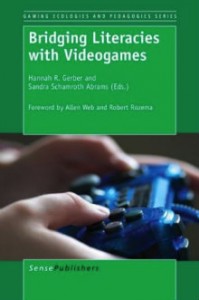Videogames in the Classroom?
Bridging Literacies with Videogames
Edited by Hannah R. Gerber and Sandra Schamroth Abrams
(Sense Publishers, 2014 – Learn more)

One of the hot trending topics in many educational circles in the past year or two has been the use of video games in the classroom to inspire learning in young people. There are all sorts of variations of this theme, from using video game websites to enhance lesson plans and concepts, to gamifying an entire curriculum (or an entire school, such as Quest to Learn), or teaching young people how to design and construct their own video games.
The pedagogical rationale for video games

Editors Hannah R. Gerber and Sandra Schamroth Abrams have grouped this book around common concepts of invented worlds; second language learners and massive multiplayer games; and gaming in the classroom setting.
As the foreword by Allen Web and Robert Rozena note, the writers of this collection “are interested in how literacy and culture evolve and how students become critical thinkers, active learners, and producers of meaning in the worlds in which they live. They are intrigued by social interaction, media literacy, and distributed decision-making.”
Kids outside the classroom
Certainly, one can’t ignore that so many of our students are spending large swaths of time outside of school constructing new worlds in Minecraft, sharing missions in World of Warcraft, thumbing through games on their mobile devices, and immersing themselves in a myriad of offerings on their Xboxes and Playstations. In fact, when we take a step back and look at the literacies underlying the games our young people are playing outside of school, it can be seen as a rich and meaningful body of work that teachers rarely acknowledge, other than as a student’s hobby, or another distraction from what we consider real literacy practice – reading books and writing essays.
A look into classroom options
In this collection, the researchers explore such possibilities as mapping out imaginary worlds to inform creative writing, how fictional storytelling informs transmedia production across media platforms, the emergence of global gaming communities of players that work together to solve problems, and how the recent push into computer programming meshes nicely with video game design elements.
An entire section focuses specifically on how second language learners can learn language from video game play, which is something I found fascinating to explore here, as the writers see the video gaming communities as a “bridge” to literacy instruction.
Literacies within World of Warcraft
The best take-away here, I think, is a chart provided by Zhuo Li, Chu-Chuan Chiu and Maria R. Coady in a chapter entitled “The Transformative Power of Gaming Literacy” that documents and outlines in a very helpful way the literacy practices that take place when a player is gaming inside the popular World of Warcraft, a massive multi-player online game.
The chart breaks down activities into such topics as Quests, Managing Characters, Exploration of Worlds, and more, and then provides a detailed list of the literacies that emerge from game play, such as reading texts to comprehend information, locating items, strategizing, problem solving, socializing, decision making, comparing, advertising, questioning and more. (P. 139)
Commercial lesson plans lack learning opportunities
Another intriguing chapter, by Mary Rice, entitled “Reviewing the Content of Videogame Lesson Plans Available to Teachers,” delves into the various video game lesson plans that are available to teachers in online spaces, noting how commercial companies are gearing their products (ie, gaming experiences) for a young audience, hooking teachers in with an easy entry point that may not always have much pedagogical value. Much of what Rice found in her own lesson plan hunt was lacking in real substance, a sign that companies are more interested in activity (for advertising and financial gain) than true learning experiences. “A teacher who wants to try to use videogames to meet standards and build growth promoting learning experiences faces significant barriers in terms of instructional support to do so, “ Rice notes. (p. 167)
A shift to student created games is needed
I would argue that teachers need to be taught how to build their own video games to meet their own learning goals for students, or even better, learn how to teach their students how to design, program, and publish original video game content. By putting the power of production into the hands of our students, we can meet many literacy goals and empower young people to look beyond the games being pushed at them. And keep them hooked on learning.
This collection provides some rationale for that movement, but not enough. The literacies that are at the heart of this book are mostly studies of students experiencing someone else’s game, not making their own games. This is the shift, from consumer of content to producer of original ideas, that we need to see happening in more classroom and more schools, and this book is yet another source to help educators see video games in a different light.
Kevin Hodgson is a sixth grade teacher in Southampton, Massachusetts, and is the technology liaison with the Western Massachusetts Writing Project. Kevin blogs regularly at Kevin’s Meandering Mind and tweets more often than is healthy under his @dogtrax handle. He also blogs about the ELA classroom here at MiddleWeb.


































